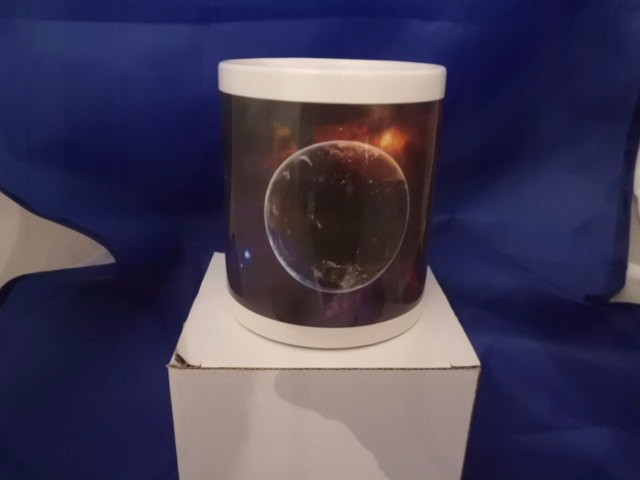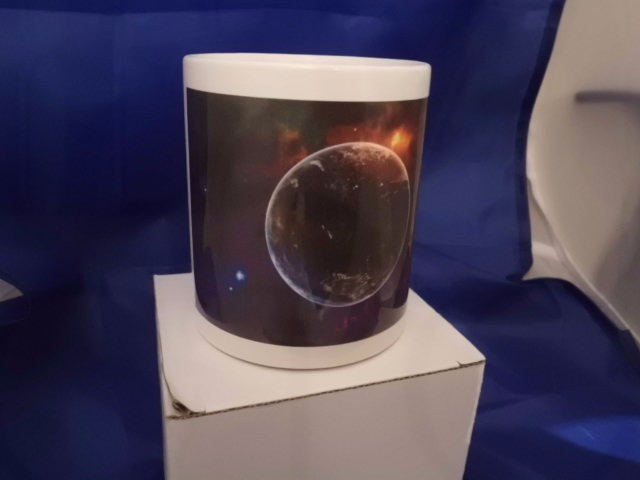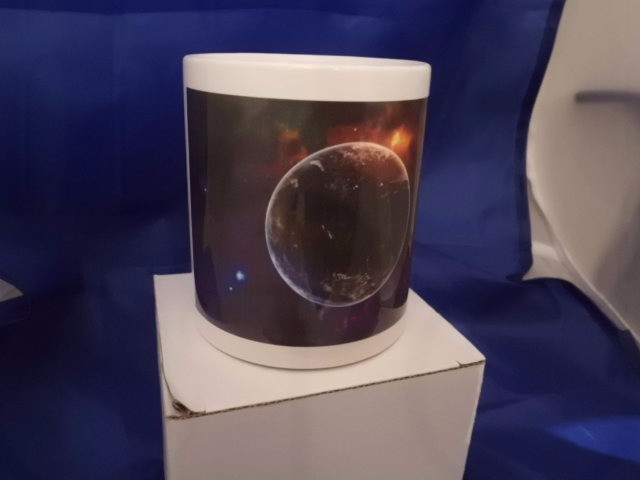Plannet personalised mug
11oz plannet mug
planet
ˈplanɪt/
noun
a celestial body moving in an elliptical orbit round a star.
the earth.
noun: the planet
"no generation has the right to pollute the planet"
ASTROLOGYhistorical
a celestial body distinguished from the fixed stars by having an apparent motion of its own (including the moon and sun), especially with reference to its supposed influence on people and events.
"the planets are presently influencing you in a positive way"
planets in our solar system didn’t appear out of nowhere. Neither did the sun. They were all part of a big cloud of gas and dust. Gravity collected lots of material in the center to create the sun. The left over stuff swirled around the forming sun, colliding and collecting together. Some would have enough gravity to attract even more gas and dust, eventually forming planets.
Scientists spent a lot of time arguing over what a planet actually is. In 2006, they came up with a definition. They said a planet must do three things. The first thing might seem obvious—it has to orbit around the sun. Second, it must be big enough to have enough gravity to force it into a spherical shape . And third, it must be big enough that its gravity cleared away any other objects of a similar size near its orbit around the Sun.
What happens if a small cloud of gas floating out in the middle of nowhere forms a sphere because its gravity? Is that a planet, too? After all, Jupiter is a big sphere of gas. And both are just a mass of stuff that wasn’t quite big enough to form a bright, fiery star.Clouds of gas that don’t have enough material to form a bright star collect into spheres all the time. Most of the time these clouds form a type of star called a brown dwarf. They are pretty big compared to most planets, but they are not big enough to turn into the kind of star that makes lots of energy and gives off light.
scientists recently discovered an even smaller gassy object in the middle of nowhere . It appears redder than most brown dwarfs, and is likely much younger than most, too. This object could have formed just like a brown dwarf—from a small cloud of gas. Or maybe it was created around a star and it somehow got flung off into space.
Some scientists are calling this object a planet. Others think that it can only be a planet if it formed around a star. They think that if it just formed from a cloud of gas, then it’s nothing more than a not-quite-star.
Science is full of arguments like this. That’s what makes it so interesting. What do you think? Do all planets, even exoplanets, need to form around stars?
Humanity’s understanding of what constitutes a planet has changed over time. Whereas our most notable magi and scholars once believed that the world was a flat disc (or ziggurat, or cube), they gradually learned that it was in fact spherical. And by the modern era, they came to understand that the Earth was merely one of several planets in the known Universe.To ancient philosophers and scholars, the Solar Planets represented something entirely different than what they do today. Without the aid of telescopes, the planets looked like particularly bright stars that moved relative to the background stars. The earliest records on the motions of the known planets date back to the 2nd-millennium BCE, where Babylonian astronomers laid the groundwork for western astronomy and astrology.
include the Venus tablet of Ammisaduqa, which catalogued the motions of Venus. Meanwhile, the 7th-century BCE MUL.APIN tablets laid out the motions of the Sun, the Moon, and the then-known planets over the course of the year (Mercury, Venus, Mars, Jupiter and Saturn). The Enuma anu enlil tablets, also dated to the 7th-century BCE, were a collection of all the omens assigned to celestial phenomena and the motions of the planets.
By classical antiquity, astronomers adopted a new concept of planets as bodies that orbited the Earth. Whereas some advocated a heliocentric system – such as 3rd-century BCE astronomer Aristarchus of Samos and 1st-century BCE astronomer Seleucus of Seleucia – the geocentric view of the Universe remained the most widely-accepted one. Astronomers also began creating mathematical models to predict their movements during this time.
This culminated in the 2nd century CE with Ptolemy’s (Claudius Ptolemaeus) publication of the Almagest, which became the astronomical and astrological canon in Europe and the Middle East for over a thousand years. Within this system, the known planets and bodies (even the Sun) all revolved around the Earth. In the centuries that followed, Indian and Islamic astronomers would added to this system based on their observations of the heavens.
By the time of the Scientific Revolution (ca. 15th – 18th centuries), the definition of planet began to change again. Thanks to Nicolaus Copernicus, Galileo Galilei, and Johannes Kepler, who proposed and advanced the heliocentric model of the Solar System, planets became defined as objects that orbited the Sun and not Earth.









